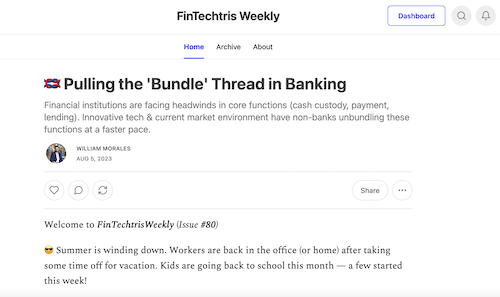FinTechs Go Back to the Drawing Board
The fintech landscape is more challenging than ever is the understatement of the year.
The shift from a period of easy capital raising to a fickle funding environment forced founders and leadership teams to hit the ‘RESET’ button on current business operations and growth initiatives.
Rising interest rates, increasing regulation, and turbulent economic headwinds altered the landscape for financial institutions, fintech platforms, and infrastructure partners.
The new focus on profitability puts pressure on execs to make strategic changes soon to avoid being shut down in 2024.
A New Mindset
Players in the financial services industry need to be agile & flexible heading into next year.
Start with examining your company’s vision, ideal customer profile, and market approach. Does this match the skillset & experience of your team?
Then check for quality growth. Growth for the sake of vanity metrics is a waste of limited resources. Smart growth that drives impactful results is the true north star.
Non-enterprise fintechs tend to move quickly in making changes. However, financial institutions sitting back watching what happens should not be taken lightly. Many banks are evaluating how new products & programs perform in the market, then focusing their budget on what new functionality is most effective. If there’s an opportunity to ‘buy’ instead of ‘build’, fintechs that are struggling and looking for buyers may be cheaper options in 2024.
STICK TO THE MISSION
When capital was free flowing (2019 - 2022), companies tossed funding at any new project that seemed compelling.
This prolonged mindset led teams to lose sight of WHY they originally built their company and WHO they were serving.
Maintaining a firm’s mission is critical in this environment, especially since mission-driven programs remain the backbone of FinTech — increasing access to financial services globally. More than clever marketing, a company’s mission helps align every employee and maintain their focus in spite of today’s industry challenges.
Unity (in light of staffing cuts back) is critical. For teammates that are still at a company, it’s important for leaders to be certain that these individuals are capable and committed to building on the foundation of the mission. Weekly team meetings and all-hands calls are essential in confirming alignment throughout an organization and the right culture is still there.
AGILE WITH REGULATION
For companies with products in a gray area (i.e. cash advances or earned wage access), re-evaluating compliance policies and potential regulatory impacts is a must.
The stance of “we’ve always operated this way” or “XYZ company has a similar program” isn’t acceptable in this type of market.
Financial institutions (especially bank partners) are being pressured to increase oversight of 3rd party partnerships by regulators. Blue Ridge Bank, Crossriver Bank, and others faced scrutiny in the last year due to their fintech partners. Banks unable to ‘beef up’ oversight are choosing to stop Banking-as-a-Service (BaaS) initiatives altogether.
Hiring for compliance leaders or working with strong risk partners should be a priority.
STAYING AWARE OF MARKET OPPORTUNITIES
Market awareness in a dynamic, changing landscape is just as important as redefining existing programs.
New opportunities that fill in gaps from competitor solutions still exist. Instead of focusing on only ‘net-new’ products, enhancing what’s already in the market (as a less costly option, or better client experience) can lead to profitability.
Some of the issues that received attention during the pandemic still need to be addressed. Cross-border payments, building credit, and instant payouts are open areas across the globe.
International opportunities are also on the horizon in which the US can connect with other regions. Canada, Mexico, and LATAM are hubs in which investment growth has picked up faster than the US. The total addressable market (TAM) is available for companies that can replicate a successful model from the US for an audience abroad.
DON’T CHASE GROWTH, FOCUS ON PROFITABILITY
We need to double down on this point.
As attractive as massive growth appears to be, continuous funding is needed to keep a company following this strategy alive. Without new investment rounds every 12-18 months, hypergrowth-focused firms will burn all their cash before reaching profitability.
Investors are prioritizing startups with product-market fit AND a near-term path to being profitable.
This path should narrow down to existing products & market segments for a fintech. Realize the full potential of current programs first, before launching something brand new (e.g. expanding to a new region or adding a secondary product). Optimize for unit economics — increasing revenue per user AND reducing maintenance costs, decreasing customer acquisition cost (CAC), and/or consolidating vendor relationships (to lower fixed monthly platform fees).
Affiliate partnerships can also become a growth engine for new business with minimal/no marketing costs. Leveraging networks of partners that are established industry veterans adds a new (cheaper) funnel for customer acquisition.
WHAT’S AT STAKE?
Becoming part of the consolidation wave in 2024, which will filter out the industry winners.
Companies that fail to keep going will become ‘buying’ targets for financial institutions & enterprises. We’ve already seen firms purchase competitors and banks level up their platform with a new fintech acquisition.
The market has spoken — no need for hundreds of neobanks, digital wallets, and micro-investment platforms. In each sector, we see the majority of market share going to 3-5 industry heavyweights.
For startups & mid-sized firms able to continue the fight for market share, make sure to firmly win in a small niche first — then slowly expand out with strategic growth planning. This may be a less exciting path for 2024, but its the difference between shutting down next year OR making it to 2025 with momentum.
Join our community @FinTechtris for more industry content & insights (including deep dives & sector spotlights).
As a bonus, access our subscriber-only resources for evaluating and building the next generation of financial services. Signup today —>


